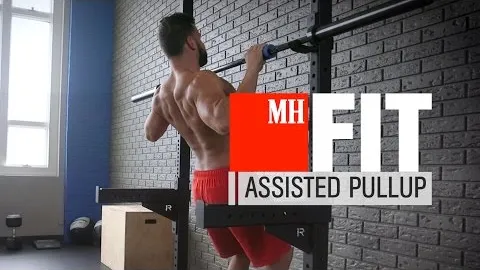
Are you looking to strengthen your upper body, specifically your back and arms? Look no further than the assisted pullup exercise. This highly effective workout targets multiple muscle groups simultaneously, helping you achieve a strong and well-defined upper body. In this article, we will dive into the benefits of assisted pullups, how to perform them correctly, and why they should be a staple in your fitness routine.
One of the primary benefits of assisted pullups is their ability to build significant upper body strength. The exercise primarily targets the latissimus dorsi muscles, commonly referred to as the lats, which are responsible for pulling your arms down and back. By incorporating assisted pullups into your routine, you'll not only strengthen your lats but also engage your biceps, shoulders, and core muscles.
Assisted pullups require a strong grip to hold onto the bar or handles. By consistently performing this exercise, you'll notice significant improvements in your grip strength, which can benefit various daily activities, such as carrying heavy objects or performing other weightlifting exercises.
Many individuals suffer from poor posture due to sedentary lifestyles or prolonged periods of sitting. Assisted pullups can help counteract this by targeting the muscles that support good posture, such as the upper back and shoulders. Regularly performing assisted pullups can help strengthen these muscles, leading to improved posture over time.
Assisted pullups are considered a compound exercise as they involve multiple muscle groups and joints working together. This makes them a great functional movement that mimics actions commonly seen in daily life, such as lifting or pulling objects. By incorporating this exercise into your routine, you'll develop strength and coordination that can be directly applied to real-life situations.
Before attempting assisted pullups, ensure you have access to an assisted pullup machine or resistance bands. Here's a step-by-step guide to executing the exercise correctly:
If using an assisted pullup machine, adjust the weight so that it provides the appropriate level of assistance based on your strength. If using resistance bands, choose a band with tension that allows you to perform the exercise with proper form.
Stand on the platform of the assisted pullup machine or place one foot in each resistance band. Reach up and grasp the pullup bar with an overhand grip, slightly wider than shoulder-width apart. Your palms should face away from you.
With your hands gripping the bar, allow yourself to hang freely with your arms fully extended. Keep your core engaged, spine neutral, and shoulders relaxed. Ensure your feet or knees are off the ground, depending on the machine or bands you are using.
Begin the pull by engaging your back muscles and squeezing your shoulder blades together. Pull your chest towards the bar, maintaining a controlled movement throughout.
Continue pulling until your chin is just above the bar or until your chest makes contact with it. Pause for a brief moment, ensuring your muscles are fully activated.
Slowly release your muscles and extend your arms to return to the starting position. Control the descent to maintain tension in your muscles.
Repeat the exercise for your desired number of repetitions, ensuring proper form is maintained. Aim for 8-12 reps to start, gradually increasing the intensity as your strength improves.
Prioritize Proper Form: Maintaining proper form is crucial to prevent injury and maximize the benefits of assisted pullups. Avoid using momentum or swinging your body during the movement. Focus on pulling with your upper body muscles and engaging your core.
Gradually Adjust Assistance: As you become stronger, gradually decrease the amount of assistance provided by the machine or resistance bands. This progressive overload will stimulate muscle growth and continued strength development.
Modify the Grip: Experiment with different grip variations to target different muscle groups. For example, an underhand supine grip will engage more bicep muscles, while a wider overhand grip will target the lats more intensely.
Mix Up Your Routine: Include variations of assisted pullups in your workouts to avoid plateaus and continuously challenge your muscles. Try using different grip positions, using a single arm, or incorporating a stability ball to engage additional muscles.
Incorporating assisted pullups into your fitness routine can be a game-changer when it comes to building upper body strength. The exercise targets multiple muscle groups simultaneously, leading to a well-rounded physique. Whether you're a beginner or an advanced athlete, the assisted pullup is a versatile exercise that can be modified to suit your fitness level. So, take advantage of this powerful compound movement, and watch your upper body strength soar to new heights!
If you're looking for a gym, fitness club or yoga studio, you've come to the right place.
You can find information about gyms in your area. Browse catalog of gyms and find gyms with classes which are you looking for.
On gym page you can find simple information like address, phone or website. You can find list of available classes. You can check availability of personal training or small group classes. On place page you can also see information about open hours.
You can find gyms near you with amenities, courts, studios and equipments.
Use our map to find gym at your city or district.
In Gym Navigator you can find list of exercises with movies for many body parts.
You can browse exercises catalog and find exercises the best of you.
You can also find exercises grouped into workout plans, which you can use to improve you body. Each routine show you exercises one by one and give you possibility to count you progress and count down rest time.